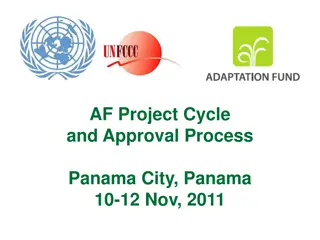Understanding the Urgency of Adaptation Planning and Financing for Climate Change
Exploring the critical need for adaptation planning and financing through National Adaptation Plans (NAPs) and Nationally Determined Contributions (NDCs) to address the adverse impacts of climate change. The content highlights the gaps, challenges, and the widening finance deficit in developing countries, emphasizing the urgent action required to bridge the adaptation finance gap and implement effective strategies for sustainable development.
Download Presentation

Please find below an Image/Link to download the presentation.
The content on the website is provided AS IS for your information and personal use only. It may not be sold, licensed, or shared on other websites without obtaining consent from the author. Download presentation by click this link. If you encounter any issues during the download, it is possible that the publisher has removed the file from their server.
E N D
Presentation Transcript
Adaptation Planning and Financing through NAPs and NDCs Rohini Kohli (UNDP) and Jessica Troni (UNEP) Source: UNDP Pakistan. 6th of July 2023
Agenda Adaptation gaps and barriers Adaptation planning and financing through NAPs and NDCs Financing nature-based solutions for adaptation Key takeaways Picture: Add source
Why adaptation? The adverse impact of climate change will cost Egypt more than 6 per cent of its GDP annually, and sea-level rise willaffect 25 per cent of its population and 90 per cent of its agricultural land (Osama Mahmoud Abdel KhalekMahmoud, Permanent Representative of Egypt to the United Nations) Climate change can reverse hard-won development gains, worsen inequalities and trigger displacement and conflict. It could drive an additional 122 million people into poverty by 2030 (IPCC 2022).
Why adaptation for Ministries of Finance? Source: Global Commission on Adaptation 2019.
Adaptation Gaps Too little, too slow Key Adaptation Gaps Current adaptation practice falls woefully short of what is required, in both nature and extent. Many initiatives prioritize immediate and near-term climate risk reduction which reduces the opportunity for transformational adaptation About 25% of the countries have a monitoring and evaluation framework in place Data availability on the effectiveness and adequacy of adaptation is poor, especially for higher warming levels. Source: UNEP 2021
The adaptation finance gap in developing countries is likely 5-10 times greater than current international finance flows and continues to widen Information on adaptation finance needs International adaptation finance reached US$29 billion in 2020 Estimated annual adaptation costs are US$160-340 billion by 2030 and US$315-565 billion by 2050 At current rates the US$100 billion pledged to developing countries will only be reached in 2025 Doubling of 2019 finance flows by 2025, as the Glasgow Climate Pact urged, requires strong acceleration NDCs: Nationally Determined Contributions NAPs: National Adaptation Plans Source: UNEP 2022 6
OUR EXISTENCE TECHNICAL CAPACITY CONSTRAINTS Barriers to Adaptation Limited institutional capacity and expertise among policymakersand local authorities to mainstream adaptation into policies, plans and investments Limited technical experience of professionals GOVERNANCE CHALLENGES Unclear institutional arrangements and decision-making procedures Lack of cross-sectoral and inter-institutional collaboration Challenges establishing effective multi-stakeholder partnerships INSUFFICIENT PUBLIC AND POLITICAL SUPPORT Lack of political leadership Limited public support due to lack of awareness, cultural constraints and entrenched preferences FINANCE CHALLENGES POLICY AND REGULATORY CHALLENGES Lack of supportive policies, strategies, regulations or inadequate enforcement of regulations Limited mainstreaming across sectors Lack of coherence across national and local policies and regulations Insufficient availability of public and private finance Insufficient financial incentives and business models Existing financial instruments and policies (i.e. perverse subsidies, incentives and tax breaks) that undermine adaptation efforts
Adaptation Planning through NDCs and NAPs NDCs NAPs Adaptation priorities and action plan Mitigation and Adaptation - vision and objectives 45 countries submitted to the UNFCCC 175 countries have submitted new or updated NDCs. 145 NDCs have adaptation components Medium to long term (5-10 years) Short to medium term (5-10 years), update every 5 years Mainly led by the Ministries of Environment, limited engagement of Ministries of Finance 1/4 of the members of the Coalition are actively involved in all stages of the NDC development and implementation process 170 countries include adaptation in their policies and planning processes
Quantifying the cost of adaptation options Financing strategies, investment plans Strengthening adaptation governance Adaptation Planning and Financing through NAPs and NDCs Mainstreaming in plans and budgets Enhancing the evidence, metrics and capacity Adaptation pipelines and projects Nature based solutions
Quantifying the cost of adaptation options Financing strategies, investment plans Strengthening adaptation governance Adaptation Planning and Financing through NAPs and NDCs Mainstreaming in plans and budgets Enhancing the evidence, metrics and capacity Adaptation pipelines and projects Nature based solutions
Bangladesh prepared a comprehensive NAP including investment plan and portfolio as well as a sector wide NDC investment strategy, assessing costs and proposing various investment opportunities and possible funding sources for NDC actions. Following the adoption of its Climate Fiscal Frameworks, Chile developed its Climate Change Finance Strategy. In Bosnia and Herzegovina, four municipalities have developed and adopted Local climate adaptation finance strategies and investment plans, developed project concepts for submission to GCF and other funds. Uruguay has developed a financing strategy for the NAP Cities, incl. possible finance instruments from domestic and international sources and opportunities for public- private partnerships. NAP financing strategies and NDC investment plans
Quantifying the cost of adaptation options Financing strategies, investment plans Strengthening adaptation governance Adaptation Planning and Financing through NAPs and NDCs Mainstreaming in plans and budgets Enhancing the evidence, metrics and capacity Adaptation pipelines and projects Nature based solutions
Mainstreaming climate change across the budget cycle Climate Public Exp & Institutional Reviews (CPEIRs) Determining climate fiscal policies and financing; including climate change in strategic planning Climate Change Budget Integration Index (CCBII) Climate Change Financing Frameworks (CCFFs) Institutionalizing role of Parliament and other accountability actors Developing climate responsive medium- term and annual budgets; estimating costs and benefits of climate investments Making the legal and regulatory environment climate responsive Climate Performance Audits (CPAs) Citizens Climate Budget (CB) Climate Cost Benefit Analysis (CCBA) Medium Term Budget /Exp Framework (MTBF/MTEF) Using CBT to generating climate expenditure reports Tracking climate relevant allocations expenditure through tagging/coding Climate Expenditure Reports Climate Budget Tagging (CBT)
Strengthening and Enhancing Adaptation Finance Climate integrated budgeting- systemic and process reforms. MTEF, budget call circular prioritizing climate finance for adaptation Bangladesh (MTEF), Mexico (Developing sustainability indicators) Estimating and roadmap for adaptation finance through fiscal frameworks and financing strategies Azerbaijan, Bangladesh, Chile, Indonesia (under review) Risk screening and climate cost benefit analysis of adaptation projects Fiji, Tonga (Risk screening for development investments) , Thailand) Planning process informed allocations for climate change adaptation investments Cambodia (system reforms), Nepal, Pakistan Climate budget tagging/expenditure review of adaptation allocations and expenditure Armenia, Eswatini, Indonesia, Namibia, Nepal, Rwanda Strengthening role of accountability actors on adaptation finance Cambodia, Nepal, Uzbekistan Private sector financing Columbia, Indonesia, Uzbekistan
Quantifying the cost of adaptation options Financing strategies, investment plans Strengthening adaptation governance Adaptation Planning and Financing through NAPs and NDCs Mainstreaming in plans and budgets Enhancing the evidence, metrics and capacity Adaptation pipelines and projects Nature based solutions
Investing in Nature- based Solutions (NbS) NbS are opportunities to simultaneously tackle climate change,biodiversity loss and land degradation
Why invest in NbS/ EbA? 1. NbS are essential tools and can cost effectively deliver on climate mitigation and adaptation, biodiversity protection and land restoration, often simultaneously. Yet they are severely underfinanced. 2. Annual current finance flows to NbS must urgently double by 2025 biodiversity loss, limit climate change to 1.5C and achieve land degradation neutrality by 2030. urgently double by 2025 if we are to halt 3. Much of the NbS finance gap ($230bn) must be filled by the private sector, both businesses and the financial sector, given government debt and fiscal constraints. 4. Reform and repurposing of environmentally harmful expenditures repurposing of environmentally harmful expenditures is urgent at $500bn to $1 trillion each year, they are 3-7 times greater than investment in nature and undermine efforts to conserve and sustainably manage biodiversity. Source: State of Finance for Nature (2022) 18
Mainstreaming Ecosystem-based Adaptation (EbA) into domestic budgets in the Gambia 4 sectoral policies (transhumance, migration, agriculture, energy) to integrate adaptation actions into their annual plans with explicit budget and monitoring structures MoF's guidelines include EbA and sectoral EbA interventions EbA integrated in the new National Development Plan Budget call circular integrates EbA Extending budget spending on EbA
Our take-aways from NAP and NDC implementation Ministries of Finance can play a key role in all stages of the NAPs and NDCs. Ministries of Finance can play a crucial role in costing adaptation options, developing financing strategies and in ensuring coherence across climate resilient investment programs more broadly. Ongoing efforts in developing climate fiscal frameworks and efforts to enhance adaptation investment can be further integratedwith NDC and NAP priorities through improved institutional coordination. Tracking adaptation finance flows to monitor and evaluate adaptation effectiveness is an important part of national adaptation M&E systems. Financing nature-based solutions for adaptation provides multiple benefits. Ministries of Finance can play a key role in reforming expenditures harmful to the environment and help mainstream nature-based solutions to national planning and budgeting processes. Ministries of Finance can enhance the enabling environment for private sector to engage and invest in adaptation.
Thank you For further information, please contact: Rohini.Kohli@undp.org Jessica.Troni@un.org























